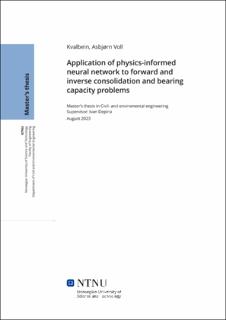| dc.contributor.advisor | Ivan Depina | |
| dc.contributor.author | Kvalbein, Asbjørn Voll | |
| dc.date.accessioned | 2023-09-28T17:23:00Z | |
| dc.date.available | 2023-09-28T17:23:00Z | |
| dc.date.issued | 2023 | |
| dc.identifier | no.ntnu:inspera:142713575:66049607 | |
| dc.identifier.uri | https://hdl.handle.net/11250/3092821 | |
| dc.description.abstract | Denne masteroppgaven undersøker applikasjonen for fysikkinformerte neurale nettverk
(FINN) i geoteknisk analyse av konsolidering og udrenert bæringskapasitet for
fram- og bakoverorienterte problemer. Et fysikkinformert neuralt nettverk er en
type dyplærings som blir begrenset av de fysiske lover som beskriver det imple-
menterte problemet. FINN blir implementert in i et vitenskapelig bibliotek kalt
DeepXDE. Ytelsen til disse modellene blir først sjekket på konsoliderings problem
før bæringskapasiet. Fram analysen søker en skjult løsning basert på de fysiske
lover som styrer problemet, gitt dets grenseverdier. Bakover analysen prøver å
approximere en ukjent tilstand for det fysiske problemet og gjennom det lære
material parameterne.
De fysiske lover om beskriver konsolideringen er her beskrevet av Terzaghis endi-
mensjonal ukoblet konsoliderings ligning, representert som en PDL. Denne lignin-
gen beskriver konsolidering gjennom å undersøke overtrykket i poretrykket, og
blir implementert inn i en FINN for fram og bakover analyse for enside og to-
side drenerte problemer. Etter disse casene blir støy introdusert til datasettet for
FINN og deretter sjekket for deres ytelse med korrupterte data. Resultatene fra
FINN blir evaluerte opp imot den analytiske løsningen for 1D konsolidering. De
implementerte FINN viser good convergens og god nøyaktighet samtidig som de
tar kort tid å trene.
De beskrivende PDLer for likevekt i 2D beskriver de fysiske lover for bæringska-
pasitets problemene. For å forsikre seg om at jorden gir etter deriveres Tresca
criteriet for udrenert Mohr-Coulomb jord og implementeres sammen med PDLene
inn i FINN. FINNen ble først implementert med kartesiske koordinater før det ble
byttet til polare. Resultatene ble evaluert opp imot resultatene for det samme
problemet i Plaxis. Både de fram- og bakover orienterte analysene for udrenert
bæringskapasitet viste god konvergens med veldig god nøyaktighet med en mod-
erat treningstid.
Generelt er det klart at konsoliderings og bæringskapasitets problem kan bli im-
plementerte inn i FINN og vise good ytelse, noe som igjen viser stort potential for
framtiden for FINN i geoteknisk ingeniørarbeid. | |
| dc.description.abstract | This thesis explores the applications of physics-infomed neural networks (PINN)
in geotechnical engineering problems of consolidation and undrained bearing ca-
pacity for forward and inverse problems. A physics-informed neural network is a
type of deep learning which is constrained by any physical laws that governs the
implemented problem, often in the way of a PDE. The PINNs are implemented
into a scientific library designed for usage of PINNs called DeepXDE. The per-
formance of these models is first checked on consolidation followed by bearing
capacity. A forward analysis seeks the hidden solution based on the physical laws
of the problem given its boundary data. The inverse analysis seeks to approximate
a unknown state for the physical problem and learn its material parameters.
The physical laws governing the consolidation is here represented by Terzaghi’s
one dimensional uncoupled consolidation equation, represented as a PDE in the
model. This equation, which predicts consolidation through excess pore pressure,
is implemented into a PINN for forward and inverse analysis of the single drained
cases, with one open permeable boundary, and the double drained cases with two
permeable boundaries. After these cases, noise is added to the datasets for the
PINNs in order to check their performance with corruption. The results from the
PINNs where evaluated up against the analytical solution for 1D consolidation.
The PINNs implemented converges well and showed good accuracy while keeping
a low time to train.
The governing PDEs for equilibrium in 2D describes the physical laws for the
bearing capacity problems. In order to ensure yielding of the soil, the Tresca cri-
terion for undrained Mohr-Coulomb soil is derived and implemented along with
the PDEs into a PINN. The PINN was first implemented with Cartesian coordi-
nates before switching to polar. The results where evaluated up against results for
the same problem in Plaxis. Both the forward and inverse analysis of undrained
bearing capacity showed very good accuracy and a modest time to train.
In general, it is clear that problems of consolidation and bearing capacity can be
implemented into PINNs and show good performance, which in turn showes great
potential for the further use of PINNs in geotechincal engineering.
i | |
| dc.language | eng | |
| dc.publisher | NTNU | |
| dc.title | Application of physics-informed neural networks to forward and inverse consolidation and bearing capacity problems | |
| dc.type | Master thesis | |
